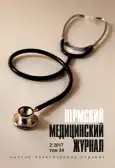OPPORTUNITIES OF CONSERVATIVE ORTHOPEDIC CORRECTION OF POSTINSULT UPPER EXTREMITY SPASTICITY
- Authors: Schekolova NB1, Zinoviev AM2
-
Affiliations:
- Пермский государственный медицинский университет им. академика Е.А. Вагнера
- Центр комплексной реабилитации инвалидов
- Issue: Vol 34, No 2 (2017)
- Pages: 15-19
- Section: Articles
- URL: https://journals.rcsi.science/PMJ/article/view/6781
- DOI: https://doi.org/10.17816/pmj34215-19
- ID: 6781
Cite item
Full Text
Abstract
Full Text
##article.viewOnOriginalSite##About the authors
N B Schekolova
Пермский государственный медицинский университет им. академика Е.А. Вагнера
Email: nb_sh@mail.ru
доктор медицинских наук, профессор кафедры травматологии, ортопедии и военно-полевой хирургии 614990 г. Пермь, ул.Петропавловская 26. Тел.8(342)221-54-16
A M Zinoviev
Центр комплексной реабилитации инвалидовтравматолог-ортопед 614090 г.Пермь, ул.Лодыгина 39, Тел.8(342)214-26-75
References
- Алагизов А.В., Кочунева О.Я. Методика аналитической лечебной гимнастики для восстановления моторики верхней конечности у пациентов, перенесших нарушение мозгового кровообращения. Лечебная физкультура и спортивная медицина 2014; 5: 14-18.
- Бондаренко Ф.В., Макарова М.Р., Турова Е.А. Основные подходы к лечению болевого синдрома в плечевом суставе после перенесенного инсульта. Вопросы курортологии, физиотерапии и лечебной физической культуры 2014; 5: 50-55.
- Бондаренко Ф.В., Макарова М.Р., Турова Е.А. Восстановление сложных двигательных функций верхней конечности у больных после ишемического инсульта. Вопросы курортологии, физиотерапии и лечебной физической культуры 2016; 1: 11-15.
- Зиновьев А.М., Щеколова Н.Б., Бронников В.А., Склянная К.А., Саитов С.А. Ортез для коррекции спастической установки кисти. Патент на полезную модель № 167069. Опубликовано 20.12.2016. Бюл. № 35.
- Королев А.А. Постинсультная спастичность: особенности развития, клиническая оценка и принципы реабилитации. Паллиативная медицина и реабилитация 2011; 3: 51-54.
- Морозов В.И., Сакута Г.А., Калинский М.И. Морфологические и биохимические аспекты повреждения и регенерации скелетных мышц при физических нагрузках и гиподинамии. Морфология 2006; 3: 88-96.
- Теленков А.А., Кадыков А.С., Вуйцик Н.Б., Козлова А.В., Кротенкова И.А. Постинсультные артропатии: феноменология, структурные изменения суставов. Альманах клинической медицины 2015; 39: 39-44.
- Щеколова Н.Б., Бронников В.А., Зиновьев А.М., Склянная К.А. Эффективность ортопедической реабилитации постинсультных больных. Пермский медицинский журнал 2016; 33 (1): 35-41.
- Щеколова Н.Б., Зиновьев А.М. Механизмы формирования ортопедических нарушений у больных после перенесенного инсульта (обзор литературы). Уральский медицинский журнал 2016; 140 (7): 90-96.
- Щеколова Н.Б., Зиновьев А.М. Принципы диагностики и коррекции ортопедических нарушений у пациентов после перенесенного инсульта. Уральский медицинский журнал 2015; 131 (8): 107-111.
- Hardwick D.D., Lang C.E. Scapular and humeral movement pattern of people with stroke during range of motion exercises. J Neurol Phys Ther 2011; 1 (35): 18-25.
- Morrey B.F., Askew L.J., Chao E.Y. A biomechanical study of normal functional elbow motion. J. Bone Joint Surg Am 1981; 63 (6): 872-877.
Supplementary files






